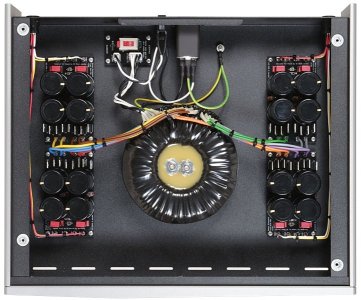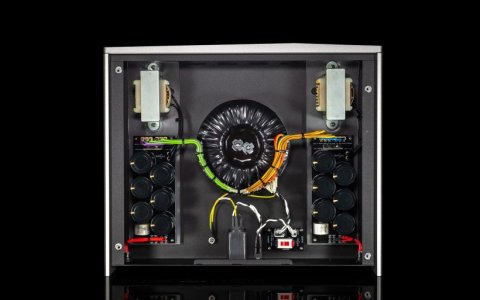So far we are not aware of any limitations at all, but i generally would advise the 'dumber' the drive the better - this is also true of external USB storage drives as well. The more features and software they claim to have (like automatic backing up etc) only get in the way or interfere.As the new NG products do not now include a drive for ripping disks is there a list of compatible USB drives that Innuos recommends? I had a Quick Look online and some drives say Windows only, some Windows (7-11) and Mac Laptop Desktop…..
Mk3 & Next-Gen: what's the difference?
- Thread starter Stephen Healy
- Start date
You are using an out of date browser. It may not display this or other websites correctly.
You should upgrade or use an alternative browser.
You should upgrade or use an alternative browser.
We are getting close now, so yes I would hope not far into Q1.Thanks again.
Do you have a time-frame for availability and approximate price for the Innuos I2S module?
I'm presuming early next year?
I’d find it helpful if you could go into more detail on the apparent change in design philosophy: you historically argued that higher powered CPU’s were inherently noisier and you therefore chose a purist approach in minimising processing power of Sense.
You now turn that on its head by arguing that the new power supply design resolves the noisy CPU issue. It franlky feels like you are bowing to Roon and their requirements more than anything else or plan to annouce future DSP plug-ins. Using Sense, can you pls elaborate further on sonic benefits over the previous generation?
Specifically my concern is that in similar vein to the Mac Mini developments, earlier versions actually had better audiophile characteristics.
You now turn that on its head by arguing that the new power supply design resolves the noisy CPU issue. It franlky feels like you are bowing to Roon and their requirements more than anything else or plan to annouce future DSP plug-ins. Using Sense, can you pls elaborate further on sonic benefits over the previous generation?
Specifically my concern is that in similar vein to the Mac Mini developments, earlier versions actually had better audiophile characteristics.
The historic choice of CPUs was not based on speed, it was based on power consumption. The situation simply now is that there are generations of i3 and i7 that consume similarly very small amounts of power, but offer better speeds so is therefore simply more efficient. This is the underlying rule of many electronics and constantly improving efficiencies in terms of relative speed/power.I’d find it helpful if you could go into more detail on the apparent change in design philosophy: you historically argued that higher powered CPU’s were inherently noisier and you therefore chose a purist approach in minimising processing power of Sense.
You now turn that on its head by arguing that the new power supply design resolves the noisy CPU issue. It franlky feels like you are bowing to Roon and their requirements more than anything else or plan to annouce future DSP plug-ins. Using Sense, can you pls elaborate further on sonic benefits over the previous generation?
Specifically my concern is that in similar vein to the Mac Mini developments, earlier versions actually had better audiophile characteristics.
On the point of Sense, are you referring to the current Sense 3 platform versus the previous 2.x generation?
Thanks Stephen,
I was referring to comparing both on SQ with the latest Sense application. As to the efficiency discussion: is Sense 3 more computationally intense than Sense 2x? Historically the leaner code structure was promotes as an advantage over Room and I have generally found the difference to be significant
I was referring to comparing both on SQ with the latest Sense application. As to the efficiency discussion: is Sense 3 more computationally intense than Sense 2x? Historically the leaner code structure was promotes as an advantage over Room and I have generally found the difference to be significant
We use accuraterip.com as a list of offset values for drives that should work:As the new NG products do not now include a drive for ripping disks is there a list of compatible USB drives that Innuos recommends? I had a Quick Look online and some drives say Windows only, some Windows (7-11) and Mac Laptop Desktop…..
We do not have an approved list just yet, but I would perhaps avoid drives that claim to work with only specific operating systems. If anything, ones that work with Mac should be fine since Mac is essentially Linux-based...
There is not huge difference in terms of computational demands (some parts were actually more efficient), but keep in mind that is all relative to the speed of the CPU etc. So, if we can keep the power consumption as low as before whilst increasing processing speeds, its win-win in terms of low noise floor and system latency/efficiency and overall smoothness/speed of the system for users.Thanks Stephen,
I was referring to comparing both on SQ with the latest Sense application. As to the efficiency discussion: is Sense 3 more computationally intense than Sense 2x? Historically the leaner code structure was promotes as an advantage over Room and I have generally found the difference to be significant
Looking at this and other info I infer that a possible entry level Zen (Mk4?) will be same/sililar price bracket as now, no internal ripping capability. So looks like Zen NG LightWhat does this mean for the future of Mk3?
Mk3 is still going strong after nearly 6 years and will still be further improved upon for years to come thanks to the new Sense 3 generation of software.
Will Mk3 be replaced? At some point yes, most likely, but the Next-Gen devices are not that replacement.
Never used an external optical devise so far. Found one which is OK from the linked list. Though not certain how this works - “(…) just enter the offset value for head alignment” - can you explain where/how these values are entered? Can’t see how it is done by hooking an external USB optical drive to a Zen NG with storage?However, we can leverage our very good ripping engine within Sense when adding an external USB optical drive - just enter the offset value for head alignment, and the external ripper will behave EXACTLY as if it was internal to the Innuos itself.
Once you connect the USB disc ripper, when you go into the Sense app Disc Ripper interface it should ask you to enter the offset value of the drive, and also provide you with a link to a database where you can check your model of USB ripper to see what its stated offset value isNever used an external optical devise so far. Found one which is OK from the linked list. Though not certain how this works - “(…) just enter the offset value for head alignment” - can you explain where/how these values are entered? Can’t see how it is done by hooking an external USB optical drive to a Zen NG with storage?
Stephen, this thread was very informative in figuring out where to place the Next-Gen series in the product line. However, as the owner of a Zenith Mk3 that I purchased new in 2020 for a much lower price, I just can't afford the Next-Gen, even with last year's trade-in offer.
Now that the Stream3 has been revealed, this is something I could afford. But reading the spec sheet, I still don't understand enough about the product to know how much of an actual upgrade we would be talking about with the Stream3 compared to the Zenith Mk3, especially in the power supply. I would find it immeasurably useful if you could write another InnSights post that compares Mk3 to the Stream series.
Also, do you know whether Innuos might consider offering some kind of trade-in offer to Mk3 owners for the Stream series?
Now that the Stream3 has been revealed, this is something I could afford. But reading the spec sheet, I still don't understand enough about the product to know how much of an actual upgrade we would be talking about with the Stream3 compared to the Zenith Mk3, especially in the power supply. I would find it immeasurably useful if you could write another InnSights post that compares Mk3 to the Stream series.
Also, do you know whether Innuos might consider offering some kind of trade-in offer to Mk3 owners for the Stream series?
I will indeed aim to do this - in the meantime I touched loosely upon some of the key benefits here:Stephen, this thread was very informative in figuring out where to place the Next-Gen series in the product line. However, as the owner of a Zenith Mk3 that I purchased new in 2020 for a much lower price, I just can't afford the Next-Gen, even with last year's trade-in offer.
Now that the Stream3 has been revealed, this is something I could afford. But reading the spec sheet, I still don't understand enough about the product to know how much of an actual upgrade we would be talking about with the Stream3 compared to the Zenith Mk3, especially in the power supply. I would find it immeasurably useful if you could write another InnSights post that compares Mk3 to the Stream series.
Also, do you know whether Innuos might consider offering some kind of trade-in offer to Mk3 owners for the Stream series?
Hi @Stephen Healy
Now it would be interesting to get complete information about Stream 3.
• What is the difference compared to
Zenith mk3.?
• Performance difference Phoenix USB reclocker vs the built-in USB reclocker.?
• What is the difference between the
different power supplies Zenith mk3 vs
Stream 3.?
• How big is the increasing difference in
sound quality between,.Zenith mk3 vs
Stream3.?
• What is the price of a Stream 3 with
1TB SDD,.to compare against an
equivalent Zenith mk3 with 1TB SSD.?
Other things that differentiate Zenith mk3 from Stream 3...
In short, if we take ZENith Mk3 versus Stream 3 then the main benefits are;
- Dedicated output module stage facility, meaning the audio output stage is now much more isolated and independently powered, allowing not just better sound but much more versatility to adapt/change.
- Better power supplies particular in terms of power regulation thanks to CX Regulator module and active rectification through the ARC6 module. Lower impedance due to much more substantial toroidal transformer. Separate power rails dedicated to output module mentioned above.
- More than 3 times the processing speed
- Real-Time Kernel support
- Separate SSD for the OS which is very robust and low-latency, independent from library storage drive.
- Much more substantial chassis for better shielding and vibration control.
- IR remote support.
- Chassis Grounding potential
In other words, the way in which the internal AC/DC rectification, regulation and distribution is quite far ahead of the ZENith Mk3 that handled this in a comparatively simpler and more passive way.
As for trade-in, I am not sure but yes we have run in this past so is entirely possible.
This is something unexpected, something I kind of wished for. Would love to hear how this works! Like a programmable IR receiver?!- IR remote support.
You'll see the new Presets section in Sense is numbered 0-9, this is so you can select it from the touch of your remote control. Stephen discusses this further in the Innsights blog for this update - https://community.innuos.com/threads/innsights-whats-new-with-sense-3-3-part-2.475/This is something unexpected, something I kind of wished for. Would love to hear how this works! Like a programmable IR receiver?!
Besides assigning numbers it’s not really clear how this works and what remote. I’ll see if this can be demoed here and if it does what I’d like to have.You'll see the new Presets section in Sense is numbered 0-9, this is so you can select it from the touch of your remote control. Stephen discusses this further in the Innsights blog for this update - https://community.innuos.com/threads/innsights-whats-new-with-sense-3-3-part-2.475/
The IR Remote side of things is still being developed, but at the very least a 'universal' one could be used and, when programmed with the right codes (TBC) then you would have:Besides assigning numbers it’s not really clear how this works and what remote. I’ll see if this can be demoed here and if it does what I’d like to have.
- Power On/Off
- Track control (play, pause, next, previous)
- Volume control (Sense digital volume)
- Preset access; using numbers 0-9 to instantly start playing music assigned to one of those numbers in Sense.
The IR Remote side of things is still being developed, but at the very least a 'universal' one could be used and, when programmed with the right codes (TBC) then you would have:
- Power On/Off
- Track control (play, pause, next, previous)
- Volume control (Sense digital volume)
- Preset access; using numbers 0-9 to instantly start playing music assigned to one of those numbers in Sense.
Sounds good! that track control is what most of us are looking for in a remote solution probably. Once 3.4 is out or whenever it's done I'll see if a dealer has setup a Stream 3 to replace my Zen mini.
@Stephen Healy
I'm excited about these new products, and as mentioned in my thread re upcoming modules, I'm looking at a major upgrade from my ZeniTH mk3 over the summer to either ZeniTH NG or Statement NG.
However one reservation I have at the moment in going all out and buying the Statement NG is the new main board & storage architecture in the ZeniTH NG. You've used various strategies to improve power usage, processing speeds, and added a separate ssd for the OS in the new range.
Have the advantages of the new Precise Audio board, Audio Core, Real Time Kernal & dedicated OS ssd, already been mitigated within the current Statement NG build, or do these new developments potentially lead us down the Statement NG+/NG2 route?
If this is the case I would rather Soldier on with my Z3 for another 6-12 months until release, rather than buy the Statement NG now and then do an RTB upgrade later.
I'm excited about these new products, and as mentioned in my thread re upcoming modules, I'm looking at a major upgrade from my ZeniTH mk3 over the summer to either ZeniTH NG or Statement NG.
However one reservation I have at the moment in going all out and buying the Statement NG is the new main board & storage architecture in the ZeniTH NG. You've used various strategies to improve power usage, processing speeds, and added a separate ssd for the OS in the new range.
Have the advantages of the new Precise Audio board, Audio Core, Real Time Kernal & dedicated OS ssd, already been mitigated within the current Statement NG build, or do these new developments potentially lead us down the Statement NG+/NG2 route?
If this is the case I would rather Soldier on with my Z3 for another 6-12 months until release, rather than buy the Statement NG now and then do an RTB upgrade later.
My Statement NG+/NG2 comment above, relates to my thoughts that the top box would be completely gutted (barring the 2 full fat Pheonix modules) then re-populated with the new main board etc.
already been mitigated within the current Statement NG build, or do these new developments potentially lead us down the Statement NG+/NG2 route?
Statement NG was just an upgrade to the power side of things, new AC/DC rectifier boards in the PSU box and new regulator boards in the server box.
Original PSU of Statement. 8 separate windings in the transformer going to 8 seperate AC/DC converters and each cable in to the server box has 4 seperate circuits.

In the NG modell the transformer is the same but the windings are connected 3+3 (2 windings are not used anymore) and only 2 rectifierboards and the cables has 4+4 wires for one voltage.

When the ZEN and ZENith NG was released with the new motherboard and GaN PSU regulators I was told that this would not be possible to do as an uppgrade to the Statement NG as the server box of the Statement was to small to fit these devices if that still is true I dont know.
The Nazare server might be the new "Statement" but there is a rather big jump in price from Statement NG to Nazare.
Similar threads
- Replies
- 3
- Views
- 712
- Replies
- 0
- Views
- 1K
- Replies
- 41
- Views
- 4K

